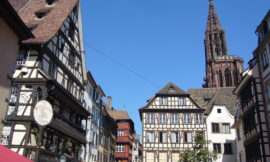Seoul, the dynamic and bustling capital of South Korea, stands as a captivating metropolis that seamlessly weaves together a rich tapestry of history, culture, and modernity. Nestled within the heart of the Korean Peninsula, Seoul is a city that has evolved over centuries, from its ancient roots as a strategic capital during the Joseon Dynasty to its current status as a global hub of technology, entertainment, and commerce.
At the core of Seoul’s historical heritage is the grandeur of its palaces. Gyeongbokgung Palace, the largest of the Five Grand Palaces built during the Joseon Dynasty, serves as an iconic symbol of Korean royalty. The palace complex, with its majestic gates, intricate architecture, and expansive courtyards, offers visitors a glimpse into the nation’s royal history. The changing of the guard ceremony at Gwanghwamun Gate is a captivating ritual that transports spectators to the bygone era of Korean monarchy.
Adjacent to Gyeongbokgung, Changdeokgung Palace and its secret garden provide a serene escape within the bustling city. Recognized as a UNESCO World Heritage site, the palace complex and its meticulously designed garden showcase the elegance of Korean palace architecture and landscaping.
Seoul’s urban landscape is characterized by a harmonious blend of modern skyscrapers and historical landmarks. The N Seoul Tower atop Namsan Mountain offers panoramic views of the city, with a skyline that stretches to the horizon. The tower serves not only as a prominent symbol but also as a romantic destination, with couples flocking to its observation decks to affix love locks and enjoy the cityscape.
Neighborhoods like Insadong and Bukchon Hanok Village preserve Seoul’s cultural authenticity. Insadong is a vibrant district known for its traditional tea houses, art galleries, and antique shops. The streets are adorned with lanterns, creating a lively atmosphere where traditional meets contemporary. In Bukchon Hanok Village, visitors can wander through narrow alleyways lined with well-preserved hanok, traditional Korean houses, providing a glimpse into Seoul’s architectural heritage.
Seoul’s technological prowess is evident in districts like Gangnam, a global symbol of affluence and modernity. Gangnam’s sleek skyscrapers, high-end boutiques, and entertainment hubs contribute to the city’s economic vitality and international allure. The district gained worldwide recognition with Psy’s “Gangnam Style,” which became a global phenomenon.
Beyond the urban landscape, the Han River flows through the heart of Seoul, providing a scenic backdrop for leisure and recreation. Parks and trails along the riverbanks offer respite from the urban hustle, attracting locals and visitors alike. Yeouido Hangang Park, located on an island in the Han River, hosts festivals, events, and offers a panoramic view of the city.
Seoul’s cultural vibrancy extends to its thriving entertainment industry, particularly the phenomenon of K-pop. The district of Dongdaemun is not only a shopping haven but also a symbolic space where global trends converge. The Dongdaemun Design Plaza, an avant-garde architectural masterpiece, serves as a hub for fashion, design, and cultural events.
Seoul’s culinary scene is a diverse and delectable journey. From iconic dishes like bibimbap and kimchi to street food delights such as tteokbokki (spicy rice cakes) and odeng (fish cakes), the city’s gastronomy reflects a harmonious blend of flavors and culinary traditions.
In conclusion, Seoul encapsulates the spirit of South Korea’s past, present, and future. The city’s ancient palaces, modern skyscrapers, cultural districts, and technological marvels create a vibrant mosaic that invites exploration and immersion. Seoul is not merely a destination; it’s an ever-evolving narrative, a city that beckons visitors to discover the layers of history, culture, and innovation that define this captivating metropolis on the Korean Peninsula.


